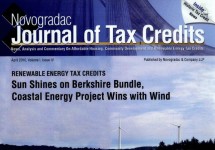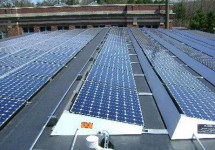|
| BERKSHIRE BUNDLE, MA - Solar Project |  Bundling Properties Saves Seven Solar Projects
By Jennifer Dockery, Staff Writer, Novogradac & Company LLP
Novogradac Journal of Tax Credits April 2010, Volume I, Issue IV
EOS Ventures, a renewable energy development and financial services company, was poised to lose $5 million last summer. The Berkshires-based company had entered solar power purchase agreements (PPAs) with seven organizations throughout its home state of Massachusetts and planned to use state grants to offset a significant portion of the installation and material costs. When Massachusetts changed the way it calculated the grant funding, EOS lost 26 percent of its grant money. The loss of grant money days before closing threatened to derail all seven projects. To preserve the projects, EOS transformed seven projects into a single project. The new project, called the “Berkshire Bundle,” qualified for renewable energy tax credits (RETCs). The RETC equity revived the project and EOS placed the seven solar arrays in service by December 31.
“This is really an example of how solar energy projects should be done and why the government should continue to look at this as a wise investment,” said Andres Garzon, Berkshire Bank’s vice president and controller. Berkshire Bank, a RETC investor since early 2009, provided equity for the project.
EOS bundled the properties into one transaction and entered into a PPA with each organization. Under the standard PPAs, EOS owns the 811-kilowatt (kW) solar arrays and sells solar energy to the sites. Any power the organizations do not use, EOS sells to local utility companies. Alteris Renewables, a design-build renewable energy company, installed the solar panels at each of the sites, and will maintain and monitor the solar arrays for EOS. The structure eliminates the need for the organizations using the solar power to provide an initial capital investment.
The Berkshire Bundle, a $4.5 million transaction, included $1.85 million in state rebates, $1.85 million in RETCs and $800,000 in debt. It produced solar arrays at seven Massachusetts sites: Bedard Brothers, a car dealership in Cheshire; Berkshire South Regional Community Center, an aquatic, fitness and educational center in Great Barrington; Hancock Shaker Village, a historic village and farm in Hancock; Quality Printing Company, a graphic, printing and mailing service company in Pittsfield; Town of West Stockbridge, a town of 1,650 in the Southern Berkshires; Brandeis University, a private research university in Waltham; and Wheeler Farm, the Wheeler School’s farm campus in Seekonk.
When EOS conceived the individual projects, the company planned to use the Massachusetts Renewable Energy Trust Commonwealth Solar Initiative grants to fund a large portion of the equipment and installation costs. EOS used the reduced grants to offset installation costs for the solar arrays.
“They scaled back the formula that determines the grant amount. That reduced our grants by about 26 percent, which was big money … They were trying to slow down the pace of distributions to make the program last longer. Unfortunately by mid-fall they stopped accepting applications completely because of lack of funds,” said EOS’s CEO Tyler Fairbank.
The Berkshire Bundle properties submitted their applications before the cutoff, so the state program provided rebates for their commercial solar systems. The grant program required the systems to be operational by year’s end.
A loan and RETC investment from Berkshire Bank filled the funding gap. Berkshire Bank, part of Berkshire Hills Bancorp, is an experienced tax credit investor that invested in eight of EOS’s 10 RETC deals last year. The community bank also had relationships with several of the organizations involved in the transaction. Because EOS placed the projects in service by year’s end, Berkshire was also able to benefit from the bonus depreciation provision included in 2008’s Housing and Economic Recovery Act. The provision allowed Berkshire to write off 60 percent its investment as a loss in 2009.
“We saw it as a higher quality tax advantage product,” Garzon said. “Having the ability to use these tax credits and not be beholden to the AMT limitations was attractive.”
For the seven organizations that received the solar arrays, the advantages of the transaction included low upfront costs and reduced energy costs. Quality Printing Company installed the panels on its BerkshireCounty headquarters to reduce greenhouse gas emissions and lower energy consumption. Alteris expects the array to produce nearly 140,000 kW-hours of energy per year. BerkshireSouthRegionalCommunity Center’s 84- kW solar array is one of many green changes that the community center has made in the past few years. Alteris estimates the system will offset 15 percent of the facility load. Bedard Brothers car dealership has a 64.4-kW array that will offset 84 percent of its facility load. HancockShakerVillage’s 89.6-kW system will produce nearly 105,000 kW-hours of energy. West Stockbridge installed the panels on its town hall to offset 43 percent of the facility load.
At BrandeisUniversity and the WheelerSchool, the panels are part of comprehensive plans to reduce their carbon footprints. Brandeis’s Climate Action Plan will eliminate 15 percent of the university’s greenhouse gas emissions by 2015 and make the campus climate neutral by 2050. Brandeis expects the Gosman Sports and ConvocationCenter’s 277-kW rooftop solar array to produce 10 percent of the center’s energy each year. The 100-kW solar system at the WheelerSchool’s Van Norman Field House is part of an award-winning green initiative the school began in 2008. The array will provide nearly 100 percent of the field house’s energy. The school uses the array as a teaching tool with students participating in the project planning.
“By converting to solar panels and having the farm run completely on solar energy, Wheeler is dramatically decreasing its environmental impact. It’s fantastic to see such a commitment being made by an institution and school,” said student Sol Taubin, co-president of Wheeler’s Environmental Concerns Organization (ECO). ECO members regularly attended planning meetings with EOS, Alteris and school officials.
The solar installations are also part of Massachusetts plan to reduce energy consumption. The state plans to support the creation of 400 megawatts of solar photovoltaic though a Solar Carve-Out Program. The new program, which replaced the grant program that funded the Berkshire Bundle, provides solar renewable energy credits to projects. The Berkshire Bundle’s financing structure is compatible with the new program and EOS plans to use the program to fund additional projects.
© Novogradac & Company LLP
2010 All rights reserved.
ISSN 2152-646X
  |
| | JIMINY PEAK CASE STUDY, HANCOCK, MA - Wind Project |  Jiminy Peak uses significant energy for snowmaking, lifts, slope lighting and heat. Rising energy costs are a concern, as passing those costs onto our guests by raising lift ticket prices, could materially jeopardize the health of our industry into the future.
Management had become increasingly aware of fossil fuel’s negative impacts on our environment and potential limited supply causing steep price increases. By August of 2005 Jiminy management was becoming acutely aware of dramatic increases in energy cost on multiple fronts. For the season ending 2004 Jiminy had spent $782,766 on energy, for the 2005 season the amount was $948,421. In just 4 months oil prices had gone up 50% by mid-summer and predications for winter electricity rates indicated there would be a 50% increase. The combined impact of these energy costs were predicated to total $1,451,000. This was prior to the impacts of hurricane Katrina. (Energy costs will exceed 1.5 million dollars for 2005-2006.) In order to help mitigate these potential concerns, Jiminy investigated the potential for a wind turbine site at the mountain.
It was determined that there was an effective turbine location at an elevation of 2,000 feet on the westerly side of the mountain, 350 feet below the summit that also decreased the visual effect on the horizon. There were no impediments from the wind for more than 70 miles to the west, extending to Utica, New York. The site chosen was on the Southwest corner of Jiminy’s 10 million gallon summit reservoir and 1,000 feet away from ski trails.
Jiminy Peak/SED proceeded in obtaining clearance in the following areas:
1. Wetlands study for the access road and site.
2. Wetlands assessment for surrounding area.
3. Avian Assessment, (bird study).
4. A determination by Massachusetts Environmental Protection Agency (MEPA) for an Environmental Notification Form (ENF).
5. Study of rare and endangered species was completed.
6. A letter of opinion was obtained from the National Heritage Society.
7. Civil engineering analysis of site and access roads.
8. Visual Impact Assessment of the project (photo simulations).
On January 3, 2006 Jiminy Peak was in contact with senior management at General Electric Energy and found them willing to assist in the purchase of a wind turbine for late summer of 2006. However, General Electric’s smallest turbine is 1.5 mw, which is taller than the 1 mw turbine initially proposed.
1 mw turbine would be a 224 foot tower structure with 88 feet blades for a total height of 312 feet. The GE 1.5mw turbine structure is 253 feet tall with 123 foot blades for a total height of 386 feet.
The GE turbine technology is proven to be a necessity in order to capture all the positive impacts of the wind. GE’s patented adjusting blade technology enables it to catch every breath of air in order to maximize generation output. GE’s sited several critical issues that needed to be answered in order to proceed further with a purchase.
- A re-evaluation of the wind study and determination of how many kilowatt hours could be generated by a GE turbine indicated it will produce 4.6 MILLION KILOWATT HOURS of electricity. (Jiminy uses 7 million kilowatt hours).
- Turbulence data was necessary in order to assure there would be no excessive vibrations to the turbine over the useful life of the next 50 years. Historical weather information proved there are no turbulence concerns.
- The ability for the turbines connection into Jiminy’s electrical distribution and National Grid’s distribution system was satisfactory answered.
- Civil Engineering and contractor capabilities for hauling this heavier piece of equipment up the mountain and installing it was resolved.
Part of the process was to determine the economic benefit of internal consumption versus power going into the grid. Jiminy was paying 12 cents per kilowatt hour for the supply side of power and would therefore get a 12 cent economic benefit for each kilowatt hour consumed internally. Based on the distribution improvements installed, 2.3 of the 4.6 million kilowatt hours would be consumed internally. The economic benefits for the power going into the grid, off campus, was 5.5 cents plus a 1.9 cents tax credit for a total of 7.4 cents. Obviously, Jiminy’s maximum benefit depended on internal consumption rather than the 4.5 cent reduction for power going into the grid.
The turbine began production in August 2007.
The total cost for the project was 3.9 million dollars.
The return on investment is predicated to take 8 years to payback.
Jiminy’s management is dedicated to this effort with the belief that sustainable type energy will add significant value to the resort in the future.
Representative Dan Bosley applauded Jiminy’s efforts by stating, "It’s great to see a local company thinking globally and acting locally."
Brian Fairbank states, "I am proud of the decision to install a turbine and believe that my great grandchildren will look favorably upon this decision to do something positive and sustainable for the environment long into the future."
  |
| | FUSS & O'NEILL CASE STUDY, MANCHESTER, CT - Solar Project |  Furthering its commitment to environmental stewardship through sound business practice, Fuss & O’Neill installed a 36 kilowatt system on the roof of its corporate headquarters in Manchester, CT. The 36 kilowatt system will produce roughly 40,000 kilowatts-hours of clean energy annually.
The solar array is comprised of one hundred nineteen 305 watt modules. The installation was made possible through a Power Purchase Agreement with EOS Ventures of Massachusetts and a grant from the Connecticut Clean Energy Fund (CCEF).
Alteris was chosen for this project over several other large solar integrators because of its Engineering Design, Project Management expertise, and demonstrated performance across its broad base of commercial installations.
Alteris installed 119 Sun Power 305 watt modules on a non-penetrating Sunlink mounting system. A 5000/7000 SunPower inverter was utilized to convert the solar DC power to AC power for the facility. Over the first twenty-five years of operation, the solar electric system will:
• Reduce CO2 emissions by 1 million pounds
• Provide the environmental equivalent of planting over 6,000 trees, or
• Effectively eliminate over 1 million miles of driving.
  |
|
|




